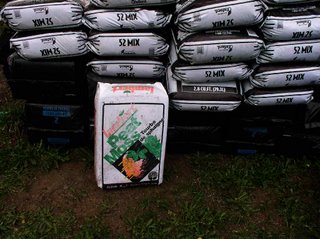 I worked in Guilford, Vermont today, down below Brattleboro and not far from the Massachusetts border. It was raining when I got there and it was pouring when I left. There are flood warnings for the next day or so and clearly if the rains I left behind are still falling, the threat is real. On the way home I thought about my gardens and how I wish they would green up like what I saw in southern Vermont. Rain makes a big difference.
I worked in Guilford, Vermont today, down below Brattleboro and not far from the Massachusetts border. It was raining when I got there and it was pouring when I left. There are flood warnings for the next day or so and clearly if the rains I left behind are still falling, the threat is real. On the way home I thought about my gardens and how I wish they would green up like what I saw in southern Vermont. Rain makes a big difference.Mother's Day is this Sunday and for many gift givers, a trip to the local nursery is a regular event. I'll bet a lot of flowering shrubs and trees are purchased as well as roses and other perennials. I'll also bet that a lot of the purchases are planted incorrectly and peat moss is part of the problem.
Gardening advice in magazines, newspapers and advertisements often speaks of the virtues of peat moss and almost make "soil amendments" and "peat" seem synonymous. Folks get the impression that digging a hole and filling with peat is a great way to plant a new prize. This is the furtherest from the truth.
Often when I give gardening talks I grab a handful of dried peat and put it in a half filled quart Mason jar as I begin. When I finish my rambling I point out the peat still floating on the top. I try to show that if peat is not thoroughly wet before going into a planting hole, it will remain dry for another million years. As the roots of the new plant begin to grow, they eventualy reach the dried peat and there they stop. If there is lots of dried peat, many roots meet the same fate and in short order the plant starves and dehydrates.
Some gardeners are hard to convince and they must use peat when they plant anything. Sometimes there are too many "My Dad did it, my Grannie did its". For those I suggest "peat soup", a thorough mix of peat and water stirred well in a big bucket or better yet a wheelbarrow. The soup means the peat is thoroughly wet and it mixes better with the soil originally removed from the hole and any other additives you think belong.
Personally I've seen some evolution in my planting methods over the years and I think the latest is the best. Here at Vermont Flower Farm the soil is very acidic clay soil which refuses to encourage good plant growth. I dig an oversize hole and add maple leaves to the bottom 6" and then add a mix of our compost. There have been times when I've run out and I've purchased from the Vermont Compost Company http://www.vermontcompost.com
A thorough mix of dirt and compost makes all the difference. Peat can be added to the mix, but in moderation and completely mixed in. If you see fellow gardeners dumping whole bags of peat into a hole, become a plant saver and give the "peat-in-the-jar" lesson. You'll help save a plant and make another gardening friend.
Gardening wishes from the hill above Peacham Pond.
George Africa
http://vermontflowerfarm.com
No comments:
Post a Comment